2024届高考英语一轮复习专题一词法第8讲非谓语动词课件(共26张PPT)
文档属性
| 名称 | 2024届高考英语一轮复习专题一词法第8讲非谓语动词课件(共26张PPT) |  | |
| 格式 | ppt | ||
| 文件大小 | 424.0KB | ||
| 资源类型 | 教案 | ||
| 版本资源 | 通用版 | ||
| 科目 | 英语 | ||
| 更新时间 | 2024-02-03 19:00:14 | ||
图片预览

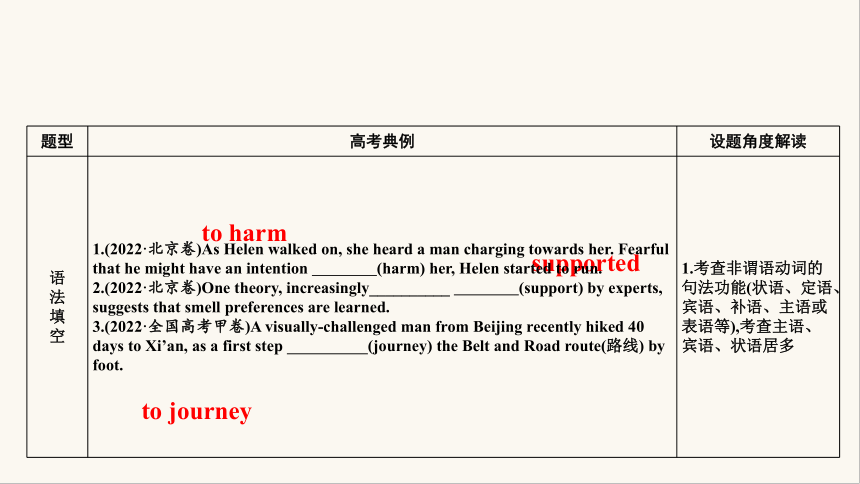


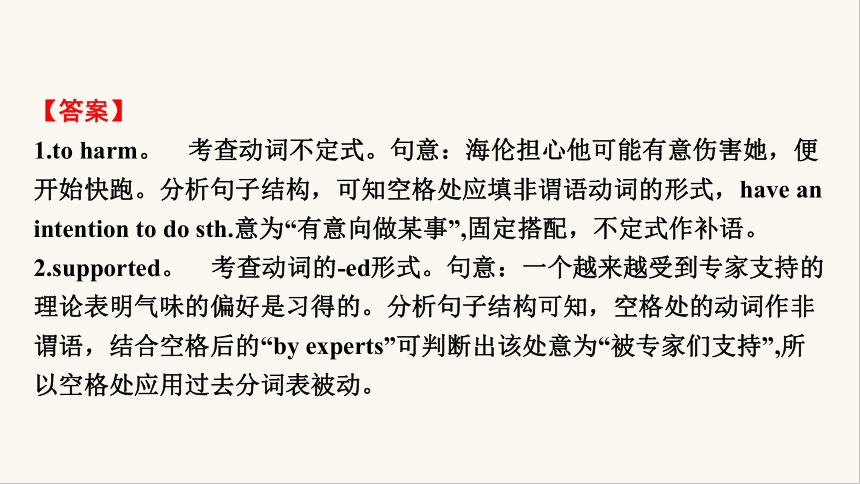
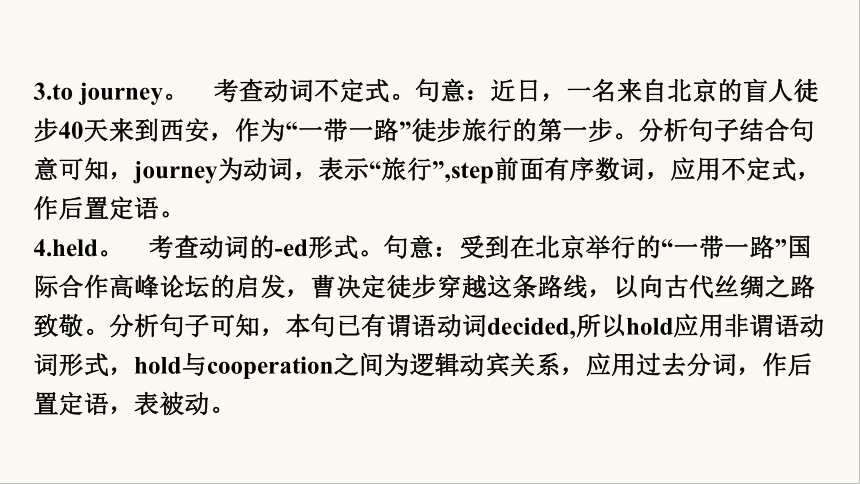
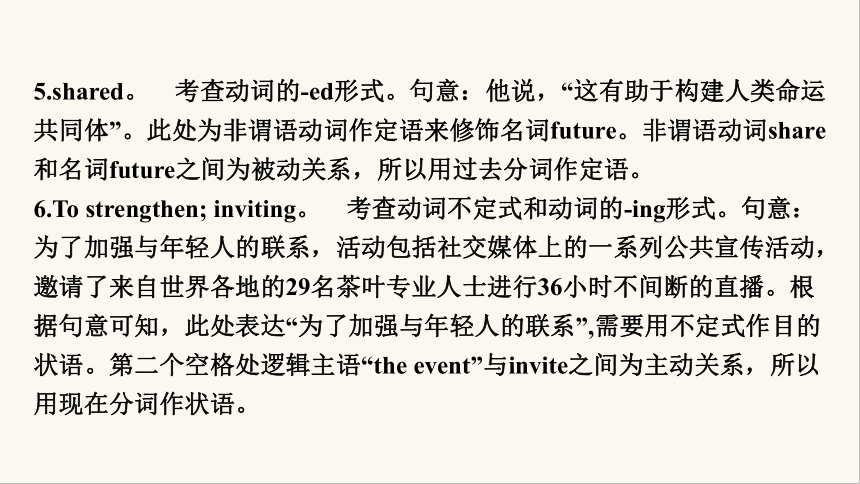

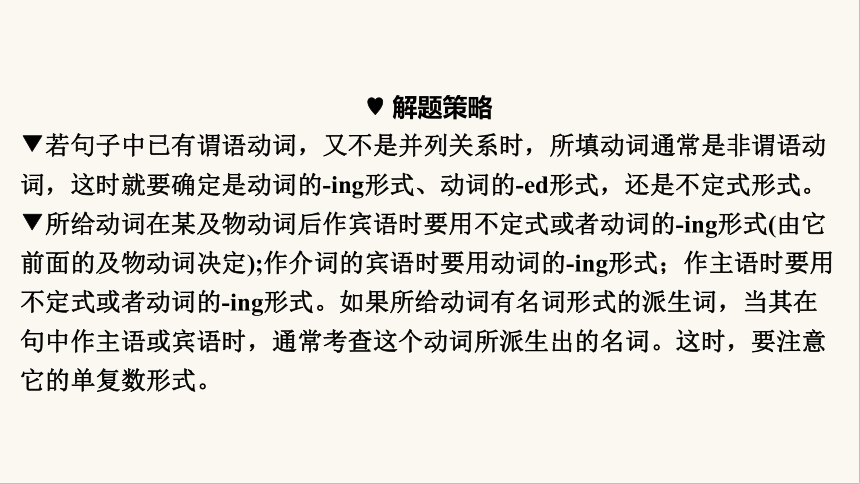
文档简介
(共26张PPT)
专题一 词法篇
第8讲 非谓语动词
supported
题型 高考典例 设题角度解读
语
法
填
空 1.(2022·北京卷)As Helen walked on, she heard a man charging towards her. Fearful that he might have an intention (harm) her, Helen started to run.
2.(2022·北京卷)One theory, increasingly__________ (support) by experts, suggests that smell preferences are learned.
3.(2022·全国高考甲卷)A visually-challenged man from Beijing recently hiked 40 days to Xi’an, as a first step (journey) the Belt and Road route(路线) by foot. 1.考查非谓语动词的句法功能(状语、定语、宾语、补语、主语或表语等),考查主语、宾语、状语居多
to harm
to journey
语
法
填
空 4.(2022·全国高考甲卷)Inspired by the Belt and Road Forum for International Cooperation _____ (hold) in Beijing, Cao decided to cover the route by hiking as a tribute(致敬) to the ancient Silk Road.
5.(2022·全国高考乙卷)“It can help to build a community with a (share) future for mankind,” he said. 2.考查固定搭配中的非谓语动词
held
shared
语
法
填
空 6.(2022·全国高考乙卷) (strengthen) the connection with young people, the event included a number of public promotional activities on social media, (invite) twenty-nine tea professionals from around the world to have thirty-six hours of uninterrupted live broadcasts.
7.(2022·全国新高考Ⅱ卷)Henry ran one hundred metres, jumped over a 1.2-metre fence, and held out his arms to catch the (fall) child. 2.考查固定搭配中的非谓语动词
To strengthen
inviting
falling
【答案】
1.to harm。 考查动词不定式。句意:海伦担心他可能有意伤害她,便开始快跑。分析句子结构,可知空格处应填非谓语动词的形式,have an intention to do sth.意为“有意向做某事”,固定搭配,不定式作补语。
2.supported。 考查动词的-ed形式。句意:一个越来越受到专家支持的理论表明气味的偏好是习得的。分析句子结构可知,空格处的动词作非谓语,结合空格后的“by experts”可判断出该处意为“被专家们支持”,所以空格处应用过去分词表被动。
3.to journey。 考查动词不定式。句意:近日,一名来自北京的盲人徒步40天来到西安,作为“一带一路”徒步旅行的第一步。分析句子结合句意可知,journey为动词,表示“旅行”,step前面有序数词,应用不定式,作后置定语。
4.held。 考查动词的-ed形式。句意:受到在北京举行的“一带一路”国际合作高峰论坛的启发,曹决定徒步穿越这条路线,以向古代丝绸之路致敬。分析句子可知,本句已有谓语动词decided,所以hold应用非谓语动词形式,hold与cooperation之间为逻辑动宾关系,应用过去分词,作后置定语,表被动。
5.shared。 考查动词的-ed形式。句意:他说,“这有助于构建人类命运共同体”。此处为非谓语动词作定语来修饰名词future。非谓语动词share和名词future之间为被动关系,所以用过去分词作定语。
6.To strengthen; inviting。 考查动词不定式和动词的-ing形式。句意:为了加强与年轻人的联系,活动包括社交媒体上的一系列公共宣传活动,邀请了来自世界各地的29名茶叶专业人士进行36小时不间断的直播。根据句意可知,此处表达“为了加强与年轻人的联系”,需要用不定式作目的状语。第二个空格处逻辑主语“the event”与invite之间为主动关系,所以用现在分词作状语。
7.falling。 考查动词的-ing形式。句意:亨利跑了100米,跳过了1.2米高的栅栏,伸出双臂去接要掉下来的孩子。句中的“hold out”为谓语动词,空格处应该使用非谓语动词。根据句意,fall为动词,意为“掉落”, child和fall之间是主动关系,同时表示正在进行的含义。故应该使用现在分词作定语。
解题策略
▼若句子中已有谓语动词,又不是并列关系时,所填动词通常是非谓语动词,这时就要确定是动词的-ing形式、动词的-ed形式,还是不定式形式。
▼所给动词在某及物动词后作宾语时要用不定式或者动词的-ing形式(由它前面的及物动词决定);作介词的宾语时要用动词的-ing形式;作主语时要用不定式或者动词的-ing形式。如果所给动词有名词形式的派生词,当其在句中作主语或宾语时,通常考查这个动词所派生出的名词。这时,要注意它的单复数形式。
★核心精讲→归纳如何学
非谓语动词的形式及意义
非谓语动词 主动语态 被动语态 意义
不定
式 一般式 to do to be done 表示的动作与句中谓语动词的动作同时发生或在其后发生
不定
式 进行式 to be doing — 表示的动作与句中谓语动词的动作同时发生
完成式 to have done to have been
done 表示的动作发生在句中谓语动词的动作之前
动词的 ing
形式 一般式 doing being
done 表示的动作与句中谓语动词的动作同时发生,或基本上同时发生
完成式 having
done having
been
done 表示的动作先于句中谓语动词的动作发生
动词的-ed
形式 一般式 done — 与句中主语为逻辑上的被动关系,表完成
非谓语动词作状语
1.动词不定式作状语,表示目的、结果、原因等
(1)作目的状语,有时用in order to或so as to。
We will continue our campaign to prevent and control air pollution to make our sky blue again.
我们将继续我们的运动,以预防和控制空气污染,使我们的天空再次蔚蓝。
(2)作结果状语,常用结构enough to,too…to…, only to 等。
I’m too tired to stay up any longer.
我太累了,实在不能熬夜了。
(3)作原因状语,此时常与表示情感的形容词连用,如glad, happy, sad, frightened, surprised 等。
I was frightened to find that in front of my door sat a dog.
我惊恐地发现门前坐着一只狗。
2.动词的-ing 形式作状语
(1)动词的-ing 形式作状语,常表原因、伴随、时间、结果等,与句子主语之间存在逻辑上的主谓关系。
His parents died, leaving him an orphan.
他的父母去世了,留下他成了孤儿。
(2)动词不定式作结果状语时,常表示意想不到的结果;而动词的-ing 形式作结果状语时,常表示自然而然的结果。
3.动词的-ed形式作状语
(1)动词的-ed形式作状语,分词与句子主语之间存在逻辑上的动宾关系。
Seriously injured, she had to be sent to hospital at once.
她严重受伤了,不得不被立刻送往医院。
(2)某些动词的-ed形式已经形容词化,且往往用于一些系表结构中,此时这些词既不表示被动,也不表示完成,而表示一种状态,如lost(迷路的),seated(坐着的),hidden(隐瞒的),lost/absorbed in(沉溺于),dressed in(穿着……的),tired of(对……感到厌倦的)等。
Absorbed in the book, he didn’t notice me enter the room.
他完全被这本书所吸引,没有注意到我进入房间。
非谓语动词作定语
1.动词不定式作定语
动词不定式作定语通常置于所修饰的名词或代词之后,与所修饰的词之间构成逻辑上的主谓、动宾关系或同位关系。
She is always the first to come and the last to leave.(主谓关系)
她总是第一个来最后一个离开。
I want some paper to write on.(动宾关系)
我想要一些写字的纸。
His last appeal, to come and see her, went unanswered.(同位关系)
没有人答应他要来看她的最后请求。
2.动词的-ing形式作定语
当该动词与被修饰的名词之间为主谓关系或用来表示被修饰的名词的用途时,用动词的-ing 形式。
The lecture, starting at 7:00 p.m.last night, was followed by an observation of the moon with telescopes.
始于昨天晚上7点的这次演讲,紧跟在用望远镜对月球进行观测之后。
No flying machine will fly from New York to Paris.
没有飞行器会从纽约飞到巴黎。
3.动词的-ed形式
(1)动词的-ed形式作定语时,它与被修饰的名词之间是逻辑上的动宾关系。
Tsinghua University, founded in 1911, is home to a great number of outstanding figures.
众多杰出人物从始建于1911 年的清华大学毕业。
(2)作定语的不及物动词的分词形式为doing和done;doing 表示正在进行,而done 表示已经完成。
非谓语动词作补语
1.感官动词(see,watch,observe,notice,look at,hear,listen to,feel等)后面的补语常见的有三种非谓语动词形式(do/doing/done)。do 表主动和完成(被动句中的to须还原),doing表主动或正在进行,done 表被动或完成。
The missing boy was last seen playing near the river.
失踪的小男孩最后一次被看到时,正在河边玩耍。
2.动词let,make,have,get,leave,keep,find等后接非谓语动词(常为省略to的动词不定式)作补语。
On the contrary, those who let teenagers experience the consequences of their actions can do better.
相反,那些让青少年经历了他们行动结果的人能够做得更优秀。
3.固定短语,如advise/allow/warn/encourage/request sb.to do sth.等。
4.with/without的复合结构:with+n.+doing (主动、进行)/done(被动、完成)/to do(目的、将来)。
Without anyone noticing, I slipped into the room.
没有人注意到,我偷偷溜进了房间。
非谓语动词作宾语
1.只接不定式作宾语的动词:agree,intend,plan,demand,promise,prepare,decide,refuse,choose,wish,hope,expect,fail(未能),pretend,manage,determine,beg,arrange,threaten,claim,hesitate,wait,happen(碰巧)等。
She seated herself at a small table in the restaurant,waiting to be served.
她坐在餐馆里的一张小桌子旁等着被服务。
2.只接动词的-ing 形式作宾语的动词及短语:admit,avoid,consider,escape(避开),imagine,mind,miss,practise,suggest,feel like,give up,put off,object to,look forward to等。此外,have difficulty/trouble (in) doing sth.,have fun (in) doing sth.等句型中也用动词的-ing 形式作宾语。
It’s quite hot today.Do you feel like going for a swim
今天很热。你想去游泳吗
【注意】
(1)动词want,need,require作“需要”讲时,其后要用动词的-ing形式或不定式的被动形式作宾语。与此用法类似的动词还有deserve。
(2)不定式作动词learn,decide,know,wonder,show,tell,understand,explain,teach,advise及动词短语find out 等的宾语时,前面可以带疑问词how,what,whether,where,when,who 等。
(3)连词but后接不定式作宾语,若前面有实义动词do,不定式要省略to。
非谓语动词作主语
非谓语动词中能作主语的有:动词的-ing形式和动词不定式
(1)动词的-ing形式作主语表示一般的、抽象的或习惯性的动作,动词不定式作主语表示具体的、一次性的或尚未做的动作。
Facing up to your problems rather than running away from them is the best approach to working things out.
直面问题而不是逃避问题是解决事情的最佳途径。
(2)it作形式主语,代替真正的主语(动词不定式或动词的-ing形式)。常见句型有:
It’s important for the figures to be updated regularly.
经常性地更新数据是非常重要的。
非谓语动词作表语
1.非谓语动词中能作表语的有:动词的-ing形式、 动词的-ed 形式和不定式。动词的-ing 形式作表语时,意为“令人感到……的”,而动词的-ed形式作表语时,意为“感到……的”。
2.get,become,look,seem,appear 等系动词后可跟动词的-ed形式作表语,表示被动或主语的状态。
This quotation from Winston Churchill tells us that we shouldn’t get discouraged right after failure.
温斯顿·丘吉尔的这句话告诉我们,失败之后不应该气馁。
专题一 词法篇
第8讲 非谓语动词
supported
题型 高考典例 设题角度解读
语
法
填
空 1.(2022·北京卷)As Helen walked on, she heard a man charging towards her. Fearful that he might have an intention (harm) her, Helen started to run.
2.(2022·北京卷)One theory, increasingly__________ (support) by experts, suggests that smell preferences are learned.
3.(2022·全国高考甲卷)A visually-challenged man from Beijing recently hiked 40 days to Xi’an, as a first step (journey) the Belt and Road route(路线) by foot. 1.考查非谓语动词的句法功能(状语、定语、宾语、补语、主语或表语等),考查主语、宾语、状语居多
to harm
to journey
语
法
填
空 4.(2022·全国高考甲卷)Inspired by the Belt and Road Forum for International Cooperation _____ (hold) in Beijing, Cao decided to cover the route by hiking as a tribute(致敬) to the ancient Silk Road.
5.(2022·全国高考乙卷)“It can help to build a community with a (share) future for mankind,” he said. 2.考查固定搭配中的非谓语动词
held
shared
语
法
填
空 6.(2022·全国高考乙卷) (strengthen) the connection with young people, the event included a number of public promotional activities on social media, (invite) twenty-nine tea professionals from around the world to have thirty-six hours of uninterrupted live broadcasts.
7.(2022·全国新高考Ⅱ卷)Henry ran one hundred metres, jumped over a 1.2-metre fence, and held out his arms to catch the (fall) child. 2.考查固定搭配中的非谓语动词
To strengthen
inviting
falling
【答案】
1.to harm。 考查动词不定式。句意:海伦担心他可能有意伤害她,便开始快跑。分析句子结构,可知空格处应填非谓语动词的形式,have an intention to do sth.意为“有意向做某事”,固定搭配,不定式作补语。
2.supported。 考查动词的-ed形式。句意:一个越来越受到专家支持的理论表明气味的偏好是习得的。分析句子结构可知,空格处的动词作非谓语,结合空格后的“by experts”可判断出该处意为“被专家们支持”,所以空格处应用过去分词表被动。
3.to journey。 考查动词不定式。句意:近日,一名来自北京的盲人徒步40天来到西安,作为“一带一路”徒步旅行的第一步。分析句子结合句意可知,journey为动词,表示“旅行”,step前面有序数词,应用不定式,作后置定语。
4.held。 考查动词的-ed形式。句意:受到在北京举行的“一带一路”国际合作高峰论坛的启发,曹决定徒步穿越这条路线,以向古代丝绸之路致敬。分析句子可知,本句已有谓语动词decided,所以hold应用非谓语动词形式,hold与cooperation之间为逻辑动宾关系,应用过去分词,作后置定语,表被动。
5.shared。 考查动词的-ed形式。句意:他说,“这有助于构建人类命运共同体”。此处为非谓语动词作定语来修饰名词future。非谓语动词share和名词future之间为被动关系,所以用过去分词作定语。
6.To strengthen; inviting。 考查动词不定式和动词的-ing形式。句意:为了加强与年轻人的联系,活动包括社交媒体上的一系列公共宣传活动,邀请了来自世界各地的29名茶叶专业人士进行36小时不间断的直播。根据句意可知,此处表达“为了加强与年轻人的联系”,需要用不定式作目的状语。第二个空格处逻辑主语“the event”与invite之间为主动关系,所以用现在分词作状语。
7.falling。 考查动词的-ing形式。句意:亨利跑了100米,跳过了1.2米高的栅栏,伸出双臂去接要掉下来的孩子。句中的“hold out”为谓语动词,空格处应该使用非谓语动词。根据句意,fall为动词,意为“掉落”, child和fall之间是主动关系,同时表示正在进行的含义。故应该使用现在分词作定语。
解题策略
▼若句子中已有谓语动词,又不是并列关系时,所填动词通常是非谓语动词,这时就要确定是动词的-ing形式、动词的-ed形式,还是不定式形式。
▼所给动词在某及物动词后作宾语时要用不定式或者动词的-ing形式(由它前面的及物动词决定);作介词的宾语时要用动词的-ing形式;作主语时要用不定式或者动词的-ing形式。如果所给动词有名词形式的派生词,当其在句中作主语或宾语时,通常考查这个动词所派生出的名词。这时,要注意它的单复数形式。
★核心精讲→归纳如何学
非谓语动词的形式及意义
非谓语动词 主动语态 被动语态 意义
不定
式 一般式 to do to be done 表示的动作与句中谓语动词的动作同时发生或在其后发生
不定
式 进行式 to be doing — 表示的动作与句中谓语动词的动作同时发生
完成式 to have done to have been
done 表示的动作发生在句中谓语动词的动作之前
动词的 ing
形式 一般式 doing being
done 表示的动作与句中谓语动词的动作同时发生,或基本上同时发生
完成式 having
done having
been
done 表示的动作先于句中谓语动词的动作发生
动词的-ed
形式 一般式 done — 与句中主语为逻辑上的被动关系,表完成
非谓语动词作状语
1.动词不定式作状语,表示目的、结果、原因等
(1)作目的状语,有时用in order to或so as to。
We will continue our campaign to prevent and control air pollution to make our sky blue again.
我们将继续我们的运动,以预防和控制空气污染,使我们的天空再次蔚蓝。
(2)作结果状语,常用结构enough to,too…to…, only to 等。
I’m too tired to stay up any longer.
我太累了,实在不能熬夜了。
(3)作原因状语,此时常与表示情感的形容词连用,如glad, happy, sad, frightened, surprised 等。
I was frightened to find that in front of my door sat a dog.
我惊恐地发现门前坐着一只狗。
2.动词的-ing 形式作状语
(1)动词的-ing 形式作状语,常表原因、伴随、时间、结果等,与句子主语之间存在逻辑上的主谓关系。
His parents died, leaving him an orphan.
他的父母去世了,留下他成了孤儿。
(2)动词不定式作结果状语时,常表示意想不到的结果;而动词的-ing 形式作结果状语时,常表示自然而然的结果。
3.动词的-ed形式作状语
(1)动词的-ed形式作状语,分词与句子主语之间存在逻辑上的动宾关系。
Seriously injured, she had to be sent to hospital at once.
她严重受伤了,不得不被立刻送往医院。
(2)某些动词的-ed形式已经形容词化,且往往用于一些系表结构中,此时这些词既不表示被动,也不表示完成,而表示一种状态,如lost(迷路的),seated(坐着的),hidden(隐瞒的),lost/absorbed in(沉溺于),dressed in(穿着……的),tired of(对……感到厌倦的)等。
Absorbed in the book, he didn’t notice me enter the room.
他完全被这本书所吸引,没有注意到我进入房间。
非谓语动词作定语
1.动词不定式作定语
动词不定式作定语通常置于所修饰的名词或代词之后,与所修饰的词之间构成逻辑上的主谓、动宾关系或同位关系。
She is always the first to come and the last to leave.(主谓关系)
她总是第一个来最后一个离开。
I want some paper to write on.(动宾关系)
我想要一些写字的纸。
His last appeal, to come and see her, went unanswered.(同位关系)
没有人答应他要来看她的最后请求。
2.动词的-ing形式作定语
当该动词与被修饰的名词之间为主谓关系或用来表示被修饰的名词的用途时,用动词的-ing 形式。
The lecture, starting at 7:00 p.m.last night, was followed by an observation of the moon with telescopes.
始于昨天晚上7点的这次演讲,紧跟在用望远镜对月球进行观测之后。
No flying machine will fly from New York to Paris.
没有飞行器会从纽约飞到巴黎。
3.动词的-ed形式
(1)动词的-ed形式作定语时,它与被修饰的名词之间是逻辑上的动宾关系。
Tsinghua University, founded in 1911, is home to a great number of outstanding figures.
众多杰出人物从始建于1911 年的清华大学毕业。
(2)作定语的不及物动词的分词形式为doing和done;doing 表示正在进行,而done 表示已经完成。
非谓语动词作补语
1.感官动词(see,watch,observe,notice,look at,hear,listen to,feel等)后面的补语常见的有三种非谓语动词形式(do/doing/done)。do 表主动和完成(被动句中的to须还原),doing表主动或正在进行,done 表被动或完成。
The missing boy was last seen playing near the river.
失踪的小男孩最后一次被看到时,正在河边玩耍。
2.动词let,make,have,get,leave,keep,find等后接非谓语动词(常为省略to的动词不定式)作补语。
On the contrary, those who let teenagers experience the consequences of their actions can do better.
相反,那些让青少年经历了他们行动结果的人能够做得更优秀。
3.固定短语,如advise/allow/warn/encourage/request sb.to do sth.等。
4.with/without的复合结构:with+n.+doing (主动、进行)/done(被动、完成)/to do(目的、将来)。
Without anyone noticing, I slipped into the room.
没有人注意到,我偷偷溜进了房间。
非谓语动词作宾语
1.只接不定式作宾语的动词:agree,intend,plan,demand,promise,prepare,decide,refuse,choose,wish,hope,expect,fail(未能),pretend,manage,determine,beg,arrange,threaten,claim,hesitate,wait,happen(碰巧)等。
She seated herself at a small table in the restaurant,waiting to be served.
她坐在餐馆里的一张小桌子旁等着被服务。
2.只接动词的-ing 形式作宾语的动词及短语:admit,avoid,consider,escape(避开),imagine,mind,miss,practise,suggest,feel like,give up,put off,object to,look forward to等。此外,have difficulty/trouble (in) doing sth.,have fun (in) doing sth.等句型中也用动词的-ing 形式作宾语。
It’s quite hot today.Do you feel like going for a swim
今天很热。你想去游泳吗
【注意】
(1)动词want,need,require作“需要”讲时,其后要用动词的-ing形式或不定式的被动形式作宾语。与此用法类似的动词还有deserve。
(2)不定式作动词learn,decide,know,wonder,show,tell,understand,explain,teach,advise及动词短语find out 等的宾语时,前面可以带疑问词how,what,whether,where,when,who 等。
(3)连词but后接不定式作宾语,若前面有实义动词do,不定式要省略to。
非谓语动词作主语
非谓语动词中能作主语的有:动词的-ing形式和动词不定式
(1)动词的-ing形式作主语表示一般的、抽象的或习惯性的动作,动词不定式作主语表示具体的、一次性的或尚未做的动作。
Facing up to your problems rather than running away from them is the best approach to working things out.
直面问题而不是逃避问题是解决事情的最佳途径。
(2)it作形式主语,代替真正的主语(动词不定式或动词的-ing形式)。常见句型有:
It’s important for the figures to be updated regularly.
经常性地更新数据是非常重要的。
非谓语动词作表语
1.非谓语动词中能作表语的有:动词的-ing形式、 动词的-ed 形式和不定式。动词的-ing 形式作表语时,意为“令人感到……的”,而动词的-ed形式作表语时,意为“感到……的”。
2.get,become,look,seem,appear 等系动词后可跟动词的-ed形式作表语,表示被动或主语的状态。
This quotation from Winston Churchill tells us that we shouldn’t get discouraged right after failure.
温斯顿·丘吉尔的这句话告诉我们,失败之后不应该气馁。
